After mastering hiragana, one of the three Japanese writing systems, the natural next step is to learn katakana, the second Japanese syllabary. Commonly used to write loanwords, katakana represent the same set of sounds as hiragana, but they look completely different.
Katakana characters are typically boxier and more geometric, with sharp corners, in contrast to hiragana’s soft, flowing curves.
Many learners find katakana a bit tricky at first. Some characters look quite similar to each other, and it’s easy to mix them up. But don’t worry! In this guide, we’ll explain what katakana is, when to use it, and provide a free printable katakana chart to help you memorize and practice with ease.
Just started learning Japanese? Explore beginner-friendly courses at Coto Academy, available both online and in person in Tokyo! Contact us today!
What is Katakana?
Katakana, written カタカナ, is one of the three main scripts used in the Japanese writing system, alongside hiragana and kanji. It is a phonetic syllabary, meaning that each character represents a specific sound or syllable, not an idea or meaning like kanji.
Katakana consists of 46 basic characters, such as ka (カ), shi (シ), or to (ト), plus their additional modified forms. Both katakana and hiragana — and the Japanese language as a whole — are built around five core vowels: A, I, U, E, and O.
Beyond the basic characters, there are also modified versions that represent long vowels and double consonants. There are also combination sounds like kya, shu, and cho.
The five vowels in katakana and hiragana look something like below:
| Katakana | Romanization | Pronunciation | Example |
| ア | A | ah | “art” |
| イ | I | ee | “see” |
| ウ | U | oo | “food” |
| エ | E | eh | “met” |
| オ | O | oh | “go” |
This system might feel very different if you’re coming from English, which only has 5 vowel letters, but nearly 20 vowel sounds — plus many diphthongs (blended vowel sounds like in ride or loud).
Read More: Differences Between English and Japanese Language
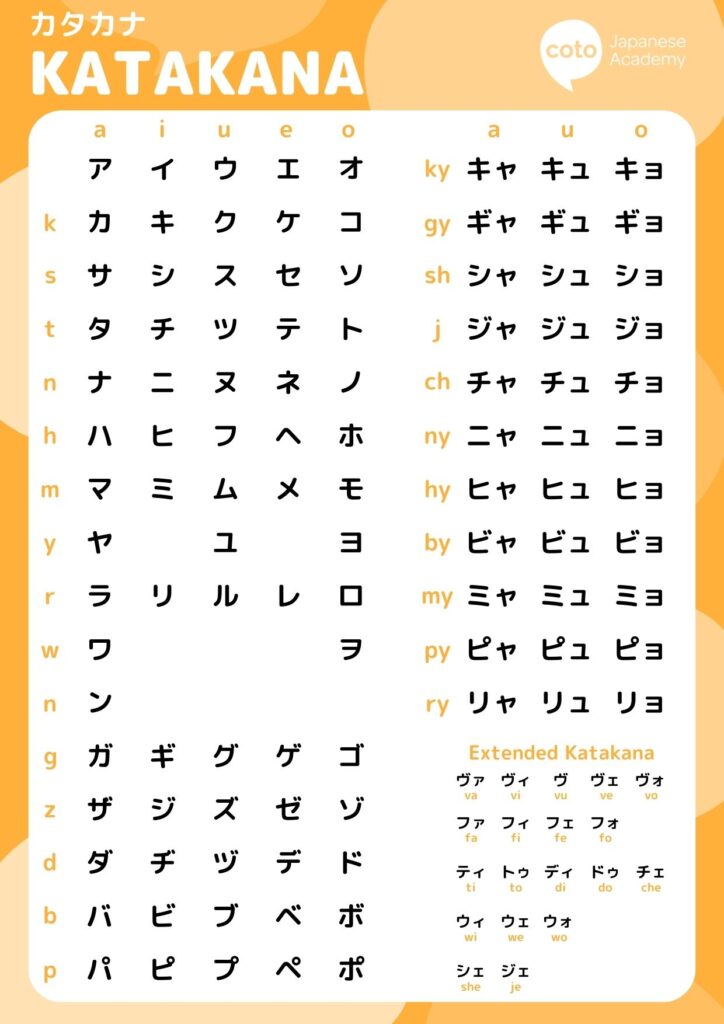
Download Free Katakana Chart
To get started, download this chart, which includes all the katakana characters (including the variations) you’ll be learning on this page.
If you have access to a printer, printing it out can be helpful, but you can also follow along digitally if you prefer, or save them as a picture so you can review them on your phone!
If you haven’t already, be sure to also download our free hiragana chart, which also includes a printable practice sheet!
Katakana Chart Overview
Like hiragana, basic katakana consists of 46 core characters that represent the fundamental sounds of the Japanese language.
However, katakana is especially useful for adapting foreign words, and this is where dakuten, handakuten, and small kana combinations come into play. These diacritical marks allow for more flexible pronunciation in both native and borrowed words.
Dakuten (゛) and handakuten (゜) are small marks that change the pronunciation of certain characters:
- Dakuten (゛) adds a voiced sound (e.g. k → g, s → z)
- Handakuten (゜) adds a “p” sound (used only with ハ-row sounds)
Here’s how they modify the basic katakana characters through dakuten and handakuten:
| K to G | S to Z | T to D | H to B | H to P |
| カ → ガ (ga) | サ → ザ (za) | タ → ダ (da) | ハ → バ (ba) | ハ → パ (pa) |
| キ → ギ (gi) | シ → ジ (ji) | チ → ヂ (ji) | ヒ → ビ (bi) | ヒ → ピ (pi) |
| ク → グ (gu) | ス → ズ (zu) | ツ → ヅ (zu) | フ → ブ (bu) | フ → プ (pu) |
| ケ → ゲ (ge) | セ → ゼ (ze) | テ → デ (de) | ヘ → ベ (be) | ヘ → ペ (pe) |
| コ → ゴ (go) | ソ → ゾ (zo) | ト → ド (do) | ホ → ボ (bo) | ホ → ポ (po) |
How to Use the Katakana Chart Effectively
Using our katakana chart effectively involves understanding its purpose, practicing regularly, and applying it in context. Here’s a guide to help you make the most out of your Katakana learning:
1. Familiarize yourself with the chart layout
The Katakana chart is organized by consonant-vowel pairs (e.g., ka, ki, ku, ke, ko).
2. Practice slowly
Start by memorizing the basic 46 characters before moving on to extended sounds (like ガ, ギ, グ).
A tip is to learn katakana one consonant line per day — such as starting with the “K” katakana, and then moving on to the “T.” Breaking the whole chart into smaller study sessions helps with retaining the characters more effectively and avoiding burnout.
3. Practice writing each character
Use the stroke order indicated in the chart to write each character neatly. Writing helps reinforce memory and improves your ability to recognize the characters
We even recommend starting to practice writing words with katakana, so you can start applying the letters to real examples.
4. Use flashcards or apps to test recognition
Learning through flashcard apps like Anki helps you remember katakana through spaced repetition, encouraging active recall and reinforcing your memory over time. There are many recommended Anki decks for learning Japanese available.
Besides Anki, there are other great apps designed specifically for learning katakana and hiragana.
Read More: Top Japanese Learning Apps to Download
How Is Katakana Used?
While hiragana is mainly used for native Japanese words and grammar, Katakana is primarily used for foreign loanwords, though its usage extends far beyond that. Because katakana looks visually distinct from Hiragana, you can easily tell them apart in text, and this difference serves an important purpose.
1. Foreign loanwords
Called garaigo, Japanese loanwords borrowed from other languages, especially English, are written in katakana — although there are plenty of Japanese loanwords that don’t come from English.
Examples of katakana use in loanwords:
| English Translation | Katakana | Romaji |
| Computer | コンピュータ | konpyuuta |
| Television | テレビ | terebi |
| Coffee | コーヒー | koohii |
2. Foreign names and places
Names of people, places, and brands from outside Japan are written in katakana.
| English Name | Katakana | Romaji |
| John | ジョン | jon |
| Paris | パリ | pari |
| McDonald’s | マクドナルド | Makudonarudo |
If you are interested in knowing your name in Japanese, check out our useful guide on how to convert your name into Japanese and use katakana!
Read More: What Is My Name in Japanese? Japanese Name Generator
3. Onomatopoeia and sound effects
Ever heard of onomatopoeia? It’s a word that phonetically imitates or suggests the sound it describes.
Japanese onomatopoeia is a bit unique because it doesn’t just mimic sounds—it’s also used to describe movements, feelings, and states. These words are often written in katakana to express sounds or conditions.
You’ll commonly find onomatopoeia in manga, anime, and advertisements.
- ドキドキ (dokidoki) — heartbeat
- ガタン (gatan) — clatter
Read More: Fun Japanese Onomatopoeia You Need to Know
4. Emphasis on a word
In the Japanese language, katakana isn’t just used for foreign words. Katakana can also add emphasis, even if those words are traditionally written in hiragana and kanji.
Because katakana has a visually striking, angular shape, it naturally draws the reader’s attention, similar to how italics or boldface work in English.
In fact, you’ll often see katakana used this way in advertisements and signage to make key words pop.
For example:
カラダにいい!
Karada ni ii
Good for your body!
彼はすごくカッコイイ!
Kare wa sugoku カッコイイ!
He’s really cool!
5. Scientific and technical terms
Yes, katakana is also used for technical and scientific terms, including the scientific names of plants and animals. This convention helps distinguish the word from ordinary Japanese words.
Common Katakana Writing Mistakes to Avoid
Katakana can be tricky because many characters look or sound alike. Here are a few common mix-ups of similar-looking katakana.
1. シ (shi) vs. ツ (tsu)
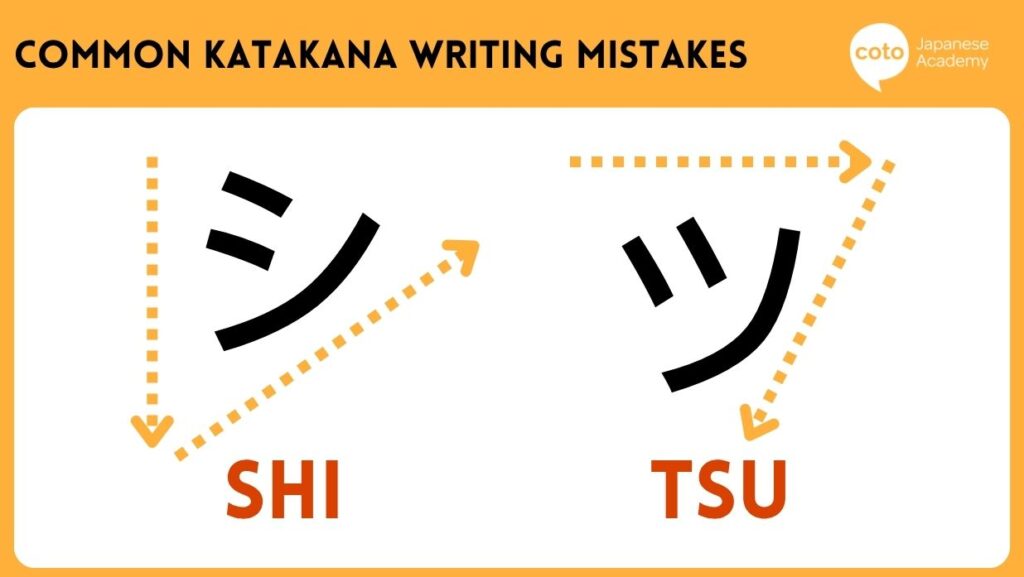
シ (shi) has three short strokes pointing downward, while ツ (tsu) has strokes pointing to the right.
2. ソ (so) vs. ン (n)
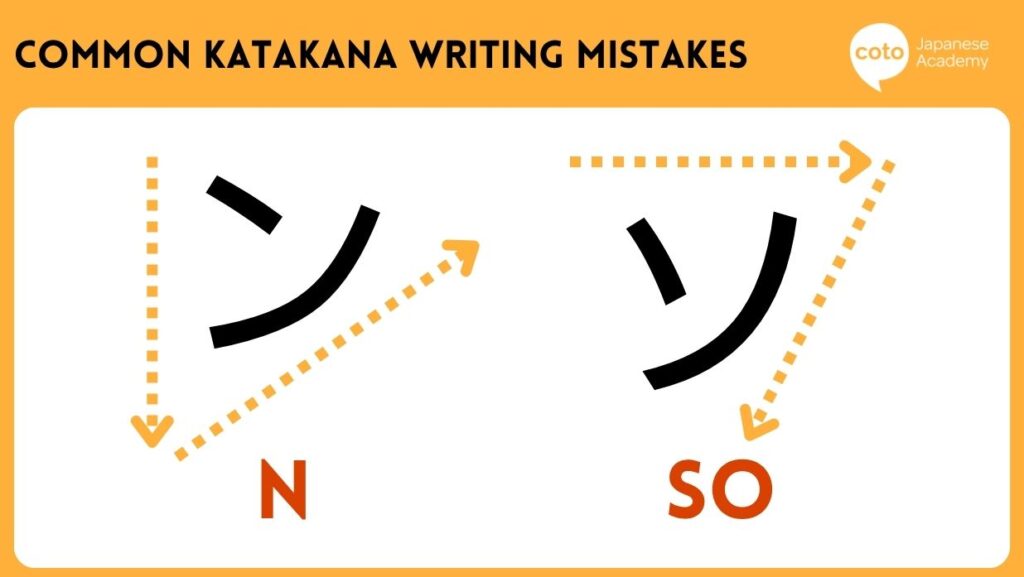
ソ (so) strokes slant down to the left, ン (n)strokes slant down to the right.
3. ヌ (nu) vs. ネ (ne)
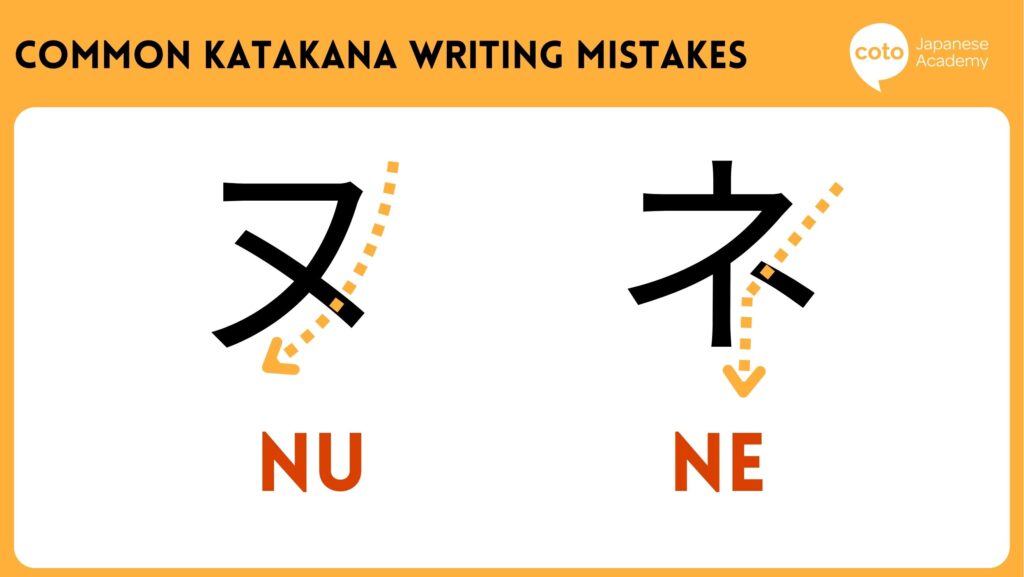
Both have diagonal strokes, but ヌ is distinguished by a small loop or hook at the bottom right, while ネ has a more angular shape with straight lines and no loop.
4. ヲ (wo) vs. ヨ (yo)
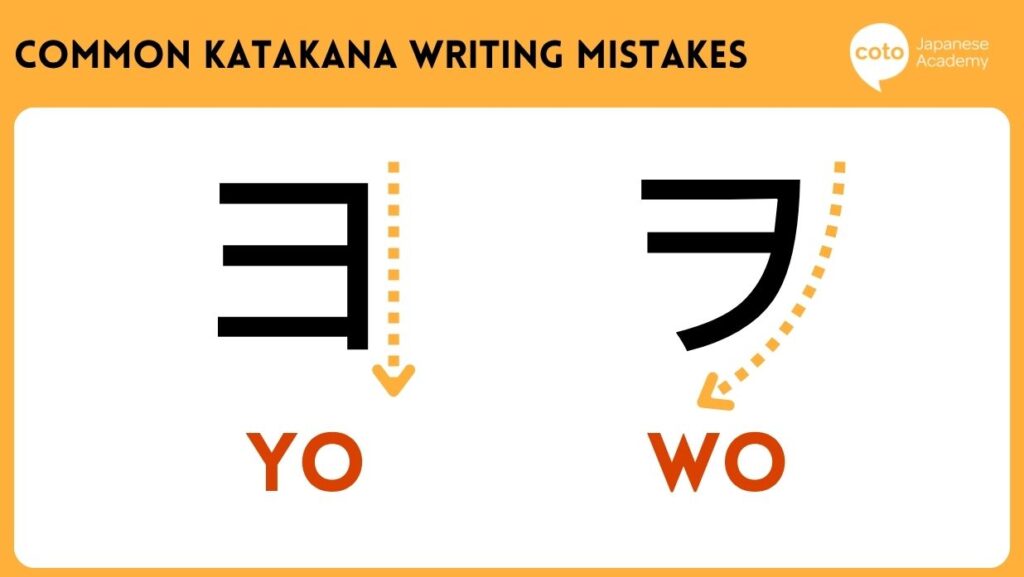
ヲ (wo) and ヨ (yo) are often mixed up because they both feature multiple horizontal strokes. However, ヲ includes a curved hook on the left side, giving it a more flowing shape, whereas ヨ consists of three straight, separate horizontal lines stacked vertically — like an inverted E!
Conclusion
There is no single way to learn Japanese, but we hope the katakana chart becomes a powerful tool to aid your study. Remember to use the chart alongside flashcards and exercises!
Ready to Start Your Japanese Learning Journey?
So what’s next? After mastering hiragana and katakana, it’s time to learn basic phrases and sentence formation.
Kickstart your journey with Coto Academy, where fun, conversation-focused classes are designed for beginners. Choose from intensive, part-time, or online Japanese courses tailored to help you reach your goals faster!
Want to study Japanese with us?
What is katakana used for?
Katakana is one of the Japanese syllabaries mainly used for writing foreign loanwords, foreign names, onomatopoeia, scientific terms, and sometimes for emphasis, similar to italics in English.
How many characters are in katakana?
Katakana has 46 basic characters representing distinct syllables, plus a few additional combinations.
What is the difference between katakana and hiragana?
Both represent the same set of sounds but are used differently. Hiragana is mostly used for native Japanese words and grammar particles, while katakana is used for foreign words, names, and emphasis.
Are there any exceptions or irregularities in katakana pronunciation?
Katakana generally follows consistent phonetic rules, but some loanwords may adapt pronunciation to fit Japanese phonology, which can sound slightly different from the original.
